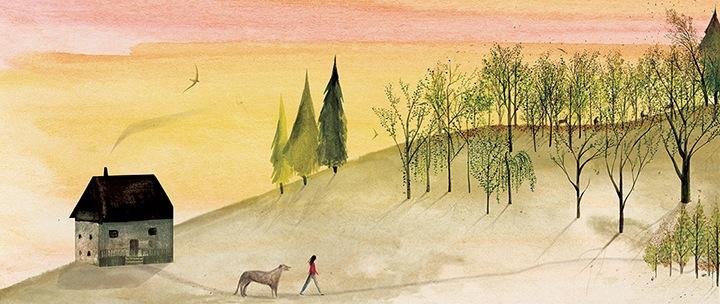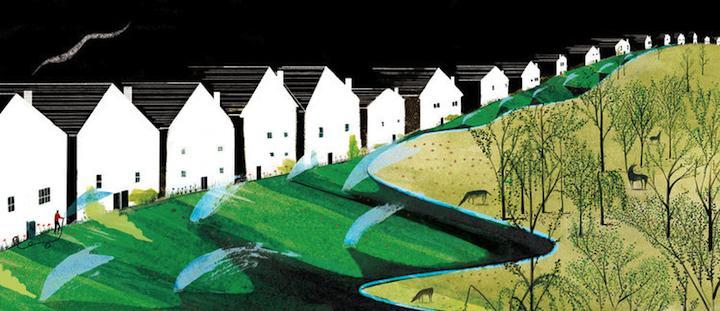Sarah Jacoby: The Q&A
Q: Originally from Philadelphia, what are some of your favorite things about living and working in New York?
A: I've recently moved to Brooklyn. Community is important to me and so a smaller, weird city like Philly is very close to my heart and I'm hoping to return some day. I'm new to New York City—it seems weird enough for me. Not that small though. I hope I don't get swallowed whole.
Q: How and when did you first become interested in art and illustration?
A: Like many illustrator types I've always been inherently creative, but I
am interested in many things. Science is fascinating, as are athletics, performance, etc. I can say, hands down, that regardless of subject matter I deeply enjoy storytelling. I was an English major
in college. I didn't take my artistic practice seriously until I started working after college. I've always held jobs, but at that point I realized that I would be working for the rest of my life and
if I didn't do something I truly enjoyed I would be a pretty miserable person. I'm lucky, I might add, to have the luxury to say that.
That's when I landed on art, illustration
specifically. I saw it as something I could commit to for the rest of my life. I suppose I wanted to try out every other option before I committed to illustration. I really didn't want to be an
artist. So much strife. But here I am. I can't help myself.

Q: Do you keep a sketchbook? What is the balance between the art you create on paper versus In the computer?
A: I do, but it's uh, lightly used. I try. I always start with paper. I really love organic shapes and tangible things. I think the computer presents a lot of opportunity to waste time and energy. But perhaps I'm saying that because I'm not as good at it as some people. It also just hurts my eyes to be staring at a screen for so long. I like generating ideas by hand and then digitally collaging/enhancing. I used the computer to finish things, but never to start them.
Q: You do a lot of design work using pattern and calligraphy. How did you become interested in this side of art and design?
A: I don't really do a lot of hand lettering, but I do love patterning. When I was in graduate school at MICA, Julia Rothman did a patterning workshop with us. Obviously, she's amazing and an inspiring person. She helped me see how simple patterns can really beautify a space or object. I've always been interested in decorative arts and that sort of thing and learning patterning is a natural fit for the sort of work I do.
Q: What do you like best about your workspace?
A: I'm in transition right now. My past space in my graduate studio in Baltimore had incredible light, open space, and a beautiful view. Not to mention a lot of great studio mates who were around a lot and generating a lot of amazing work. I miss it. Now I'm at a kitchen table and have to move all of my crap when it's time to eat. Hoping to improve on that.
Q: Do you think it needs improvement, if so, what would you change?
A: I'd like to move into a space that I can call my own soon. Maybe I could have a window. I'd really like that. Plants would be essential.
Q: What is the most important item in your studio?
A: My coffee cup. Especially
when it is filled with coffee.
Q: What is your favorite part of the creative process?
A: When I first get a project assignment I try and do a lot of research and then I nap a lot. I do this to try and get into that liminal dream space/flow and to try and catch off kilter and beautiful ideas that only arrive in waking dreams. I also really like finishing projects. I don't often know how something will end up appearing so I'm always really grateful when I am able to finish something well.
Q: What was the strangest or most unusual assignment you’ve taken? What made it a success or a failure?
A: I'm pretty new to this game, but people always want me to draw their pets (that's common, right?). A friend of a friend has a very large cat that eats ice cream. I ended up making her a drawing of the cat as a king of ice cream—you know, an ice cream crown and all that. The client cried tears of joy. People are awesome.
Q: What was your favorite book as a child?
A: I had too many. I read a lot. A LOT. Runaway Bunny. Calvin and Hobbes. A Gift of Magic by Lois Duncan. Man did I want ESP so bad as a kid.
Q: What is the best book you’ve recently read?
A: I'm reading the Wildwood Chronicles by Colin Meloy at the moment. Colin has done an excellent job of re-creating a Naria-eque series that hits all the right spots for me. Talking animals get me every time. I also just read Airships by Barry Hannah. He's one of my favorites at the moment. Fucked up southern lit. It pairs nicely with Wildwood.
Q: Who and what are some of your strongest influences?
A: You can tell I love Carson Ellis and Jon Klassen a lot. I also love Pieter Bruegal and Alice Neel for their characters, environments, and narratives. I am more inspired by writing, film, and music than anything else. So Lydia Davis is my go to writer when I'm stuck. A good Jodorowsky or Lynch film is enough to shake anyone out of a creative slump (but now that Kanye's all about Jodorowsky I can't use him anymore, right?) I am perhaps the most energized by discovering new music at live shows. The last great one I went to was in Baltimore with the band Peals.
Q: What was your first professional assignment and how did you get it?
A: I am lucky to have a friend named Jamin who
started a magazine called KillScreen. It's now associated with Pitch Fork Media. It's about video games and the surrounding culture. When he was first starting I asked if I could
work for him. I made him really terrible work, but he was very kind and published it anyway. I'm talking really bad. Embarrassing stuff. Thanks for you patience Jamin!!
Q: What was the last art exhibition you saw and what did you take away from it?
A: I last went to the Maryland Institute College of Art's Graduate thesis show last May. It was really the first time I went to a show where I truly knew the labor and thought that went into all of the work. The Rhinehart Sculpture program produced some of the best work I've seen in a long time. Shout out to Nick Primo and Jihyun Hong. Incredible craft and concept. I cried (really I did).
Q: What is/would be your karaoke song—and why?
A: I'd love to sing Sia's Chandelier because it's so powerful and I have a really quiet voice so I'm guaranteed to do a terrible/wonderful job. It's really dramatic and she says pronounces Chandelier in the best way.
Q: What do you like best about teaching?
A: I love teaching; I've taught for many years. The best part is the perspective it gives you. Seeing young, talented students create incredible work that they consider "whatever" always bends my mind. Also being in a position of authority and judgment always provides an opportunity to reconsider how I want to lead, what my values are, and what good leadership is on a grand scale. I also really like fellow teachers. Anyone who's interested in learning is cool with me.
Q: What would be your last supper?
A: I'd have Vedge (a gourmet vegan restaurant in Philly) cater it for me. Or non-vegan pizza from Pizza Brain (in Philly) and some Lefthand Sawtooth Ale.
Sarah Jacoby is an illustrator and artist, a writer and all around creative thinker and maker. When making pictures she prefers to use brushes and inks and loves calling upon memories to bring her imagery to life. In recent past, she studied literature and film at Haverford college and earned her M.F.A in at the Illustration Practice Program at Maryland Institute College of Art (MICA) in Baltimore.
Sarah has worked as a sound archivist, a coffee slinger, a digital media specialist, a lifeguard, and a movie theater projectionist among other things. This varied existence aptly portrays Sarah’s constant desire to explore, experiment, and play. For Sarah illustration is a unique and important forum in which all of these actions combine in a universal way.
Recent honors include: Society of Illustrators 56: Gold Medal, Uncommissioned work; Society of Illustrators 56: Editorial Illustration Annual; American Illustration 33 Annual; Creative Quarterly 35; Communication Arts Best of Illustration May/June 2014.





